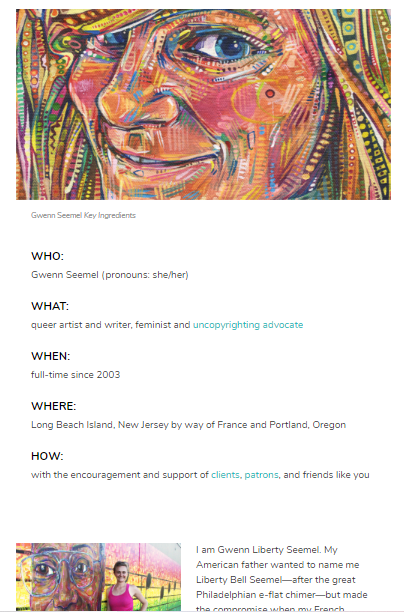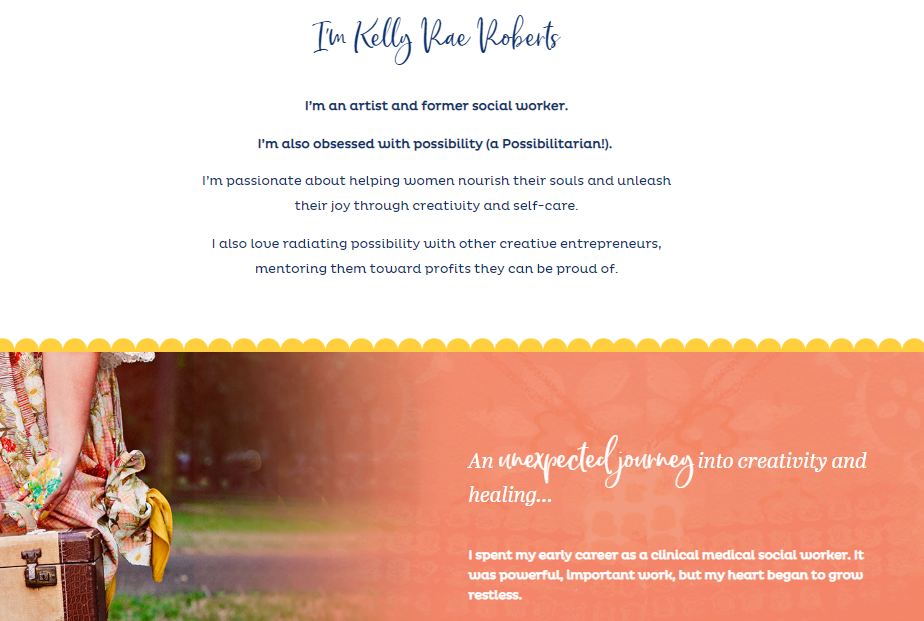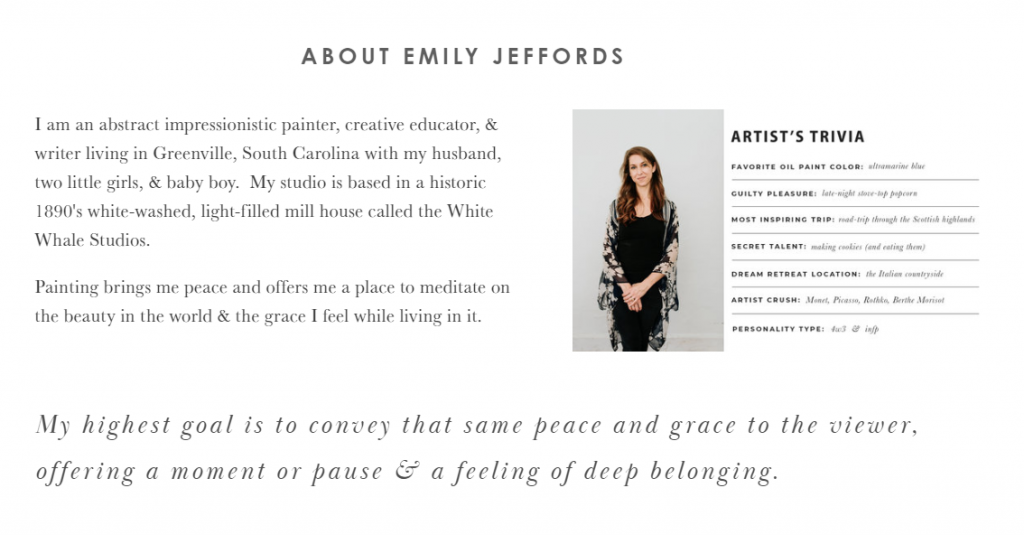What is your identity as an artist? What do you stand for? What are the high and low points of the journey that brought you here? Being able to answer these questions will put you well on your way to crafting an effective artist bio for your website.
An artist bio can be an incredibly powerful tool that significantly increases your chances of selling your art to website visitors and creating lifelong fans. Or, it can be a yawnfest that leads to a quick click of the exit button. How can you tell which better describes your artist bio right now, and how can you make it better?
What is an Artist Bio?
An artist bio is a specialized section on your website that is meant to explain who you are and what you’re about. Your artist bio is your About page.
The best part of an artist bio is that you can personalize it to reflect your brand and your voice. An artist bio may briefly explain the most important highlights of:
-How you began creating art (standout childhood art stories are always well-received)
-Your art education history
-Your best and brightest exhibitions, media mentions and collaborations
-How you began working in your current style
-What is unique about you and your work
-The main messages or themes of your work
For example, if you work in found objects/recycled materials like Dorothea LeBlanc or you created an entirely new painting technique like Sara O’Connor, that should feature on your artist bio. However, an artist bio is not the place to wax poetic about your techniques or the message you have to tell the world. Think of an artist bio as an extended elevator pitch: you’ve got a few extra floors to cover, so you can give a decent overview of who you are and what you’re about. Your artist bio is the place to explain who you are, where you’ve come from, and where you’re going. And don’t forget to include lots of images!
What an Artist Bio is NOT
An artist bio is not an artist statement. While it can be tempting to use your artist bio to expound on the philosophical underpinnings of your specific style of acrylic painting or get deeply into the spiritual side of your art practice, an artist bio is not the place for it. Your devoted audience will love to hear about the deep “why” behind your art, but your artist blog and social media channels are the best places for those stories. You can also have a separate page on your website for your “artist statement” that goes more in depth. Use your bio to instead explain about who you are, how you came to create art and the best highlights of your journey so far.
And although you should include the best career/educational highlights in your bio, your artist bio is not your curriculum vitae (CV). Potential clients and customers do not need to see an exhaustive list of every gallery your work has shown in and every school where you’ve studied. An exception may be including it at the very bottom of the page, or as a PDF download.
An artist bio is not a sales page. Each piece of art listed for sale on your website should have unique copy dedicated to selling the individual piece… but your artist bio is not the place for selling your work. Rather, consider your artist bio as contributing to the overall mission of your website: to create raving fans who will buy your work, share your work, follow you on social media, and commission you. Your artist bio is the place to sell yourself by painting an appealing and intriguing picture of who you are and what you do in such a way that readers can’t help but linger, click links, watch videos, and be inspired to peruse the work you have for sale. All of the artists we feature below do an excellent job of this, so be sure to click through and explore their bios.
How to write an awesome artist bio
An excellent artist bio that actually helps you endear yourself to collectors and sell more art is so much more than simply plugging info into a template. So while we can’t tell you exactly how to write the best artist bio for your business, we can show you some examples of what really works well for other artists. First consider the key elements to include and exclude:
Key elements to include:
Professional experience
Exhibition highlights
Award highlights
General career highlights
Elevator pitch of your work
A brief story of your trajectory toward pro artist
A photo or two of yourself working in your studio
Pitfalls to avoid:
Bloviating
Technical artspeak
Listing every single exhibition and award for the length of your career
Over-selling
Not including any images of yourself or your work
Examples of great artist bios:
Gwenn has crafted a robust artist bio that functions as a sales page for Gwenn Seemel, the artist. It includes a helpful “Who, What, Where, When, How” rundown at the very top of the page, followed by sections that expound on each with abundant videos and images sprinkled throughout. Her bio is written conversationally and is packed with links to blog posts, vlogs, and outside publications. Seemel also, wisely, includes favorable quotes about herself and her work from other publications and media appearances.

Kelly Rae Roberts has crafted a powerfully strong brand built around her story of transitioning from a social worker to a full-time artist. Steeped in aphorisms on living your truth and loving yourself and crafted in bright sunshiney hues, Roberts’ entire website is intended to communicate a positive and inclusive outlook on art. Roberts tells her story in brief in her artist bio as well as sharing tidbits about her family life. Her bio page includes a random fact generator that shares, with the click of a button titled “click here for another slumber party secret”, a fun fact about Kelly Rae. Kelly Rae Roberts’ website in general is an excellent case study for artists looking for inspiration to draw their website and brand together cohesively in both philosophy and design, and her bio page is no exception. Keep in mind that Roberts’ business is very successful, and an early career artist may not be able to invest in a copywriter and/or website designer in the same way.

Emily Jeffords uses the “above the fold” section of her bio page to give her elevator pitch, a photo of herself, and a fun section of artist trivia similar to Kelly Rae Roberts’ “slumber party secrets”. Scroll down and she provides a year-by-year history of her career as an artist from fresh out of art school optimism to financial setbacks and paradigm shifts.
The artist bio is more than a simple one-paragraph about page: it has the potential to enchant your website visitors and make them fall in love with who you are as an artist and a human being, which will greatly increase the chances that they will buy from you. A well-written artist bio will be written in a conversational or narrative style that is consistent with the copy across the rest of your website and social media presence.

If you’re struggling to identify what makes you unique or to write down your story coherently, How to Sell Your Art 101 is the perfect place to start. Along with a cohort of like-minded artists you’ll proceed through a step-by-step process to identify and write down your story in a way that will greatly improve your chances of selling your art. Read more about How to Sell Your Art 101 here: https://theabundantartist.com/htsyao101/
Leave a Reply